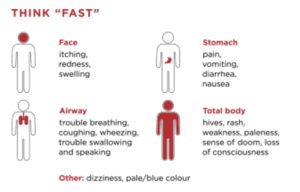Your personal data will be used to process your order, support your experience throughout this website, and for other purposes described in our privacy policy.
Anaphylaxis Reaction – Understanding Severe Allergic Reactions
In the United States, beauty practitioners must be prepared to handle various situations, including non-life-threatening but severe allergic reactions known as Anaphylaxis. These reactions are typically triggered by exposure to allergens, and the most common allergens to be aware of include nuts, fish oils, bee/wasp stings, lidocaine, and latex.
Recognizing Anaphylaxis Symptoms:
The symptoms of anaphylaxis can vary widely, ranging from localized swelling, skin redness, or an itchy rash to more severe manifestations like facial swelling, particularly around the mouth and throat. Severe cases can result in restricted breathing, dizziness, and even vasovagal reactions. Some individuals may experience a sudden onset of symptoms like nausea, vomiting, and diarrhea.
One crucial aspect to remember is that anaphylaxis can develop rapidly, demanding immediate attention and action. Under no circumstances should you leave a client unattended, no matter how challenging the situation becomes.

Managing Anaphylaxis:
In the event of a severe allergic reaction like anaphylaxis, it is essential to remain fast and calm, ensuring the safety and well-being of the affected individual:
- Stay Calm: Maintain a calm demeanor during the crisis. The client may be experiencing panic and discomfort due to their breathing difficulties. It's vital to create a reassuring environment.
- Positioning the Client: Allow the client to rest in a comfortable position. This can help slow down the progression of the reaction and buy you more time to address the situation. If the reaction is related to exposure to a chemical or substance, wash the affected area immediately with water to mitigate its effects.
- Administering Epinephrine: If the client is aware of their tendency toward anaphylaxis, they may carry an adrenaline pen containing epinephrine (adrenaline solution). In such cases, encourage them to self-administer it quickly. If they become too ill to self-administer, you should immediately call 911 (the emergency number in the United States) for permission to administer it yourself.
- Unconscious Client: If a client who is not prone to anaphylaxis loses consciousness, gently place them in the recovery position. If they stop breathing, prepare to initiate CPR (Cardiopulmonary Resuscitation) procedures. Dial 911 immediately and ask for permission to administer an epinephrine pen (always have one on-site).
Preventing Anaphylactic Reactions:
Prevention is key in managing anaphylactic reactions. You can take several precautions:
- Patch Testing: Prior to performing any treatment involving chemicals or substances, conduct a patch test on the client at least 24 hours before the actual treatment. Additionally, have them fill out a medical record card containing questions about known allergies.
- Latex-Free Gloves: Opt for latex-free gloves to avoid any potential latex-related allergic reactions.
- Dietary Restrictions: Refrain from consuming foods containing nuts or fish oils before working with clients, reducing the risk of allergen transfer.
Summary:
- Maintain Calm and Comfort: Keep the client calm and comfortable, continuously observe them for any changes in their condition.
- Wash the Affected Area: If applicable, wash the affected area immediately to minimize the impact.
- Call 911 for Ambulance: In addition to seeking permission to administer epinephrine, call 911 for an ambulance.
- Position Client in Recovery: Place the client in the recovery position, ensuring their airways remain clear.
- Initiate CPR if Necessary: If the client stops breathing, be prepared to initiate CPR.
Remember: Your preparedness and vigilance in recognizing and managing anaphylactic reactions are crucial in ensuring the safety and well-being of your clients.

